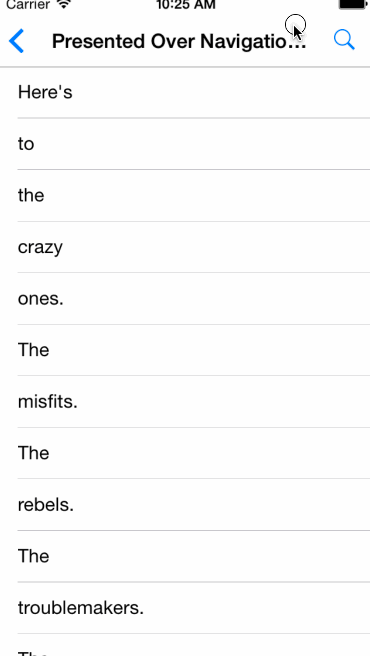本文主要是介绍【原/转】iOS中非常强大的过滤器:NSPredicate,希望对大家解决编程问题提供一定的参考价值,需要的开发者们随着小编来一起学习吧!
在APPLE的官方Demo:UICatalog中实现UISearchBar模糊搜索功能是这么做的:
1 - (void)viewDidLoad { 2 [super viewDidLoad]; 3 4 self.allResults = @[@"Here's", @"to", @"the", @"crazy", @"ones.", @"The", @"misfits.", @"The", @"rebels.", @"The", @"troublemakers.", @"The", @"round", @"pegs", @"in", @"the", @"square", @"holes.", @"The", @"ones", @"who", @"see", @"things", @"differently.", @"They're", @"not", @"fond", @"of", @"rules.", @"And", @"they", @"have", @"no", @"respect", @"for", @"the", @"status", @"quo.", @"You", @"can", @"quote", @"them,", @"disagree", @"with", @"them,", @"glorify", @"or", @"vilify", @"them.", @"About", @"the", @"only", @"thing", @"you", @"can't", @"do", @"is", @"ignore", @"them.", @"Because", @"they", @"change", @"things.", @"They", @"push", @"the", @"human", @"race", @"forward.", @"And", @"while", @"some", @"may", @"see", @"them", @"as", @"the", @"crazy", @"ones,", @"we", @"see", @"genius.", @"Because", @"the", @"people", @"who", @"are", @"crazy", @"enough", @"to", @"think", @"they", @"can", @"change", @"the", @"world,", @"are", @"the", @"ones", @"who", @"do."]; 5 6 self.visibleResults = self.allResults; 7 }
1 - (void)setFilterString:(NSString *)filterString { 2 _filterString = filterString; 3 4 if (!filterString || filterString.length <= 0) { 5 self.visibleResults = self.allResults; 6 } 7 else { 8 NSPredicate *filterPredicate = [NSPredicate predicateWithFormat:@"self contains[c] %@", filterString];9 self.visibleResults = [self.allResults filteredArrayUsingPredicate:filterPredicate]; 10 } 11 12 [self.tableView reloadData]; 13 }
其中,self.allResults是列表的全部结果,self.visibleResults是输入搜索词后出现的模糊匹配结果。流程如下图所示:

从上述代码可以看到,APPLE获取到模糊搜索结果所用的代码仅仅两行。由此可见,NSPredicate的功能不可小觑。这也是本文的目的,全方位地介绍一下在cocoa框架下的搜索匹配利器:NSPredicate。Cocoa框架中的NSPredicate用于查询,原理和用法都类似于SQL中的where,作用相当于数据库的过滤取。
1、初始化
| 1 | NSPredicate *ca = [ NSPredicate predicateWithFormat:( NSString *), ...]; |
那传入的初始化NSString到底要满足怎样的格式呢?
| 1 2 3 4 5 6 7 8 9 10 11 12 13 14 15 16 17 18 19 20 21 22 23 24 | (1)比较运算符>,<,==,>=,<=,!= 可用于数值及字符串 例:@ "number > 100" (2)范围运算符:IN、BETWEEN 例:@ "number BETWEEN {1,5}" @ "address IN {'shanghai','beijing'}" (3)字符串本身:SELF 例:@“SELF == ‘APPLE’" (4)字符串相关:BEGINSWITH、ENDSWITH、CONTAINS 例:@ "name CONTAIN[cd] 'ang'" //包含某个字符串 @ "name BEGINSWITH[c] 'sh'" //以某个字符串开头 @ "name ENDSWITH[d] 'ang'" //以某个字符串结束 注:[c]不区分大小写,[d]不区分发音符号即没有重音符号,[cd]既不区分大小写,也不区分发音符号。 (5)通配符:LIKE 例:@ "name LIKE[cd] '*er*'" //*代表通配符,Like也接受[cd]. @ "name LIKE[cd] '???er*'" (6)正则表达式:MATCHES 例: NSString *regex = @ "^A.+e$" ; //以A开头,e结尾 @ "name MATCHES %@" ,regex |
2、使用
2.1 场景1:NSArray过滤,也就是文章开头的场景
| 1 2 3 4 | NSArray *array = [[ NSArray alloc]initWithObjects:@ "beijing" ,@ "shanghai" ,@ "guangzou" ,@ "wuhan" , nil ]; NSString *string = @ "ang" ; NSPredicate *pred = [ NSPredicate predicateWithFormat:@ "SELF CONTAINS %@" ,string]; NSLog (@ "%@" ,[array filteredArrayUsingPredicate:pred]); |
2.2 场景2:判断字符串首字母是否为字母
| 1 2 3 4 5 | NSString *regex = @ "[A-Za-z]+" ; NSPredicate *predicate = [ NSPredicate predicateWithFormat:@ "SELF MATCHES %@" , regex]; if ([predicate evaluateWithObject:aString]) { } |
2.3 场景3:字符串替换
| 1 2 3 4 5 6 7 8 9 10 11 | NSError * error = NULL ; NSRegularExpression * regex = [ NSRegularExpression regularExpressionWithPattern:@ "(encoding=\")[^\"]+(\")" options:0 error:&error]; NSString * sample = @ "<xml encoding=\"abc\"></xml><xml encoding=\"def\"></xml><xml encoding=\"ttt\"></xml>" ; NSLog (@ "Start:%@" ,sample); NSString * result = [regex stringByReplacingMatchesInString:sample options:0 range: NSMakeRange (0, sample.length) withTemplate:@ "$1utf-8$2" ]; NSLog (@ "Result:%@" , result); |
2.4 场景4:截取字符串
| 1 2 3 4 5 6 7 8 9 10 11 12 13 14 15 16 17 18 19 20 21 22 | //组装一个字符串,需要把里面的网址解析出来 NSString *urlString=@ "<meta/><link/><title>1Q84 BOOK1</title></head><body>" ; //NSRegularExpression类里面调用表达的方法需要传递一个NSError的参数。下面定义一个 NSError *error; //http+:[^\\s]* 这个表达式是检测一个网址的。(?<=title\>).*(?=</title)截取html文章中的<title></title>中内文字的正则表达式 NSRegularExpression *regex = [ NSRegularExpression regularExpressionWithPattern:@ "(?<=title\\>).*(?=</title)" options:0 error:&error]; if (regex != nil ) { NSTextCheckingResult *firstMatch=[regex firstMatchInString:urlString options:0 range: NSMakeRange (0, [urlString length])]; if (firstMatch) { NSRange resultRange = [firstMatch rangeAtIndex:0]; //从urlString当中截取数据 NSString *result=[urlString substringWithRange:resultRange]; //输出结果 NSLog (@ "->%@<-" ,result); } } |
2.5 场景5:判断是否是手机号码或者电话号码
| 1 2 3 4 5 6 7 8 9 10 11 12 13 14 15 16 17 18 19 20 21 22 | //组装一个字符串,需要把里面的网址解析出来 NSString *urlString=@ "<meta/><link/><title>1Q84 BOOK1</title></head><body>" ; //NSRegularExpression类里面调用表达的方法需要传递一个NSError的参数。下面定义一个 NSError *error; //http+:[^\\s]* 这个表达式是检测一个网址的。(?<=title\>).*(?=</title)截取html文章中的<title></title>中内文字的正则表达式 NSRegularExpression *regex = [ NSRegularExpression regularExpressionWithPattern:@ "(?<=title\\>).*(?=</title)" options:0 error:&error]; if (regex != nil ) { NSTextCheckingResult *firstMatch=[regex firstMatchInString:urlString options:0 range: NSMakeRange (0, [urlString length])]; if (firstMatch) { NSRange resultRange = [firstMatch rangeAtIndex:0]; //从urlString当中截取数据 NSString *result=[urlString substringWithRange:resultRange]; //输出结果 NSLog (@ "->%@<-" ,result); } } |
2.6 场景6:验证邮箱、电话号码有效性
| 1 2 3 4 5 6 7 8 9 10 11 12 13 14 15 16 17 18 19 20 21 22 23 24 25 26 27 28 29 30 31 32 33 | //是否是有效的正则表达式 +( BOOL )isValidateRegularExpression:( NSString *)strDestination byExpression:( NSString *)strExpression { NSPredicate *predicate = [ NSPredicatepredicateWithFormat :@ "SELF MATCHES %@" , strExpression]; return [predicate evaluateWithObject:strDestination]; } //验证email +( BOOL )isValidateEmail:( NSString *)email { NSString *strRegex = @ "[A-Z0-9a-z._%+-]+@[A-Za-z0-9.-]+\\.[A-Za-z]{1,5}" ; BOOL rt = [CommonTools isValidateRegularExpression:email byExpression:strRegex]; return rt; } //验证电话号码 +( BOOL )isValidateTelNumber:( NSString *)number { NSString *strRegex = @ "[0-9]{1,20}" ; BOOL rt = [CommonTools isValidateRegularExpression:number byExpression:strRegex]; return rt; } |
2.7 场景7:NSDate筛选
| 1 2 3 4 5 6 7 8 9 10 11 12 13 | //日期在十天之内: NSDate *endDate = [[ NSDate date] retain]; NSTimeInterval timeInterval= [endDate timeIntervalSinceReferenceDate]; timeInterval -=3600*24*10; NSDate *beginDate = [[ NSDate dateWithTimeIntervalSinceReferenceDate:timeInterval] retain]; //对coredata进行筛选(假设有fetchRequest) NSPredicate *predicate_date = [ NSPredicate predicateWithFormat:@ "date >= %@ AND date <= %@" , beginDate,endDate]; [fetchRequest setPredicate:predicate_date]; //释放retained的对象 [endDate release]; [beginDate release]; |
本文转自编程小翁博客园博客,原文链接:http://www.cnblogs.com/wengzilin/p/4276612.html,如需转载请自行联系原作者
这篇关于【原/转】iOS中非常强大的过滤器:NSPredicate的文章就介绍到这儿,希望我们推荐的文章对编程师们有所帮助!







